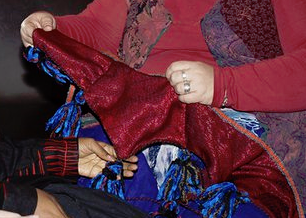Greetings, everyone. I know I've been away for months and months, so let's see if I can quickly sum up all that's been happening.
 |
| Experimenting with Transitions |
 |
| First Success |
In June, I had my last day of work after a 3-year contract. After job hunting, I was pleased to find a new position to start immediately after the July 4th holiday. So yes, good news: New job. Unusual news: Really long commute. It's not actually my longest mileage commute, but it is my longest time-on-the-clock commute. I don't mind driving, but it has been a challenge to juggle the hours missing from my schedule to be productive and crafty.
In October, I was part of the organizational staff for a large camping event. For fun and relaxation, I dug out an old UnFinished-Object (UFO) to work on some lazy afternoon at the event. I didn't bring any instruction with me, just a class sampler of card-weaving, warped up on my inkle loom, dusty and ignored for two years since I had last taken a class. I could not actually figure out the solution while I was camping, but my interest was kindled, and I was *determined* to solve the puzzle when I returned home.
This red, white, and black sampler consumed my brain. I finally remembered enough from my classes, and consulted the handouts from both Bridget's and Aldgytha's classes, until I solved the riddles. Along the way, I came up with my own mnemonic phrases to keep track with turns were next in the pattern. By the time I completed the sampler, I was completely weaving without a printed pattern.
 |
| Finished first sample, fuzzy sampler on the loom |
My next tasks included: Learning to understand how the stitches work, how to chart the patterns (and design new patterns), and then warp a project all on my own without any assistance.
To understand the stitches, I warped up four cards with the bulkiest, fuzzy yarn in my stash. The stitches were bold and easy to see, chart, examine, and understand. Then I stayed up late drawing by hand, drawing on the computer, charting in spreadsheets, and experimenting until I found the best way to make notes about card-weaving patterns. I also went online to find some card-weaving (tablet-weaving) software I'd seen several years ago. Turns out that Guntram's Tablet-Weaving Thingy charts patterns almost the same way I had been sketching over dinner one evening. I'm glad I went to the trouble to figure out charting methods. Now all the resources on the internet and in my library make more sense, having invented the wheel once myself, too.
 |
| Failed sampler. Nothing looks right, including one yarn needs to go entirely. |
 |
| "Lessons Learned" sampler set aside, warp cut and ready to remove from the loom. |
 |
| Salvaging the warp threads from the cut "lessons learned" sampler. The brown was tossed out. |
Next: warping a loom from scratch. I was actually somewhat relieved to have my first failed "need to cut it off the loom" experience.
 |
| Houston, we have a problem. Those should be closed circles. |
 |
| This looks promising. |
 |
| Yeah, I got this. *grin* |
Now I'm trying to write up my lessons learned, for my own handouts or crib notes. Several card-weavers and textile artists around me are looking forward to seeing how I solved these tricks. And I'm happily enjoying yet another way to play with string.
Want to browse all the photos? You can find them here: / Google+ / Picasa / Facebook








































